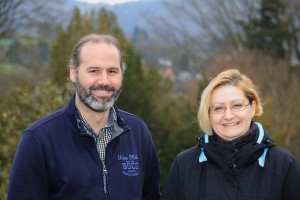ESO Supernova Planetarium & Visitor Center
ESO Supernova – Planetarium and Visitor Center[vc_empty_space height=”20px”][dt_fancy_separator separator_style=”thick” separator_color=”default”][vc_empty_space height=”20px”]
Space, stars and the Universe hold an almost magical attraction for many people. While astronomy is a vivid and rapidly evolving science, transferring current and new knowledge from researchers to the public is often difficult and daily work limits it to rare occasions for most scientists. The ESO Supernova visitor center in Garching near Munich shall bridge the gap between astronomical research and the interested public, allowing visitors to get updated on the current status of astronomy, on recent discoveries and let visitors become and remain inspired by the fascination of the Universe we live in.
The Supernova project group here at HITS contributes the scientific expertise to the development of the content for the exhibition. And much beyond that, it explores and develops interactive exhibits specifically for the ESO Supernova that will allow visitors to dive into a broad range of topics by means of interactive computer simulations, virtual reality, and state-of-the-art computer graphics. This will enable the visitors to discover astronomy in an individual way, deepen their understanding of astronomy, and share their experience and fascination with others.
A broad range of professional expertise is covered by the two developers, Dr. Dorotea Dudaš and Dr. Volker Gaibler, from computer graphics and numerical mathematics to astronomy and theoretical astrophysics. Project Manager is Dr. Kai Polsterer, leader of the Junior group Astroinformatics.
The ESO Team at HITS:
Dr. Kai Polsterer
E-Mail: kai.polsterer@h-its.org
Phone +49 6221 – 533 – 314
Fax +49 6221 – 533 – 298
Dr. Dorotea Dudaš
E-Mail: dorotea.dudas@h-its.org
Phone.: +49 6221 – 533 – 317
Fax: +49 6221 – 533 – 298
Dr. Volker Gaibler
E-Mail: volker.gaibler@h-its.org
Phone: +49 6221 – 533 – 317
Fax: +49 6221 – 533 – 298
More information:
ESO Supernova
The ESO Supernova will be a magnificent showcase for astronomy for the public. It is made possible by a collaboration between the Heidelberg Institute for Theoretical Studies (HITS) and ESO. The Klaus Tschira Stiftung (KTS), a German foundation that supports the natural sciences, mathematics and computer science, offered to fully fund the construction and ESO will run the facility. The striking building was designed by the architects Bernhardt + Partner.
ESO
ESO is the foremost intergovernmental astronomy organisation in Europe and the world’s most productive ground-based astronomical observatory by far. It is supported by 16 countries: Austria, Belgium, Brazil, the Czech Republic, Denmark, France, Finland, Germany, Italy, the Netherlands, Poland, Portugal, Spain, Sweden, Switzerland and the United Kingdom, along with the host state of Chile. ESO carries out an ambitious programme focused on the design, construction and operation of powerful ground-based observing facilities enabling astronomers to make important scientific discoveries. ESO also plays a leading role in promoting and organising cooperation in astronomical research. ESO operates three unique world-class observing sites in Chile: La Silla, Paranal and Chajnantor. At Paranal, ESO operates the Very Large Telescope, the world’s most advanced visible-light astronomical observatory and two survey telescopes. VISTA works in the infrared and is the world’s largest survey telescope and the VLT Survey Telescope is the largest telescope designed to exclusively survey the skies in visible light. ESO is a major partner in ALMA, the largest astronomical project in existence. And on Cerro Armazones, close to Paranal, ESO is building the 39-metre European Extremely Large Telescope, the E-ELT, which will become “the world’s biggest eye on the sky”.
Klaus Tschira Stiftung
The Klaus Tschira Stiftung promotes the advancement of the natural sciences, mathematics, and computer science, and wants to raise appreciation for these fields. The Foundation’s commitment begins in the kindergarten and is pursued in schools, universities, and research facilities.
